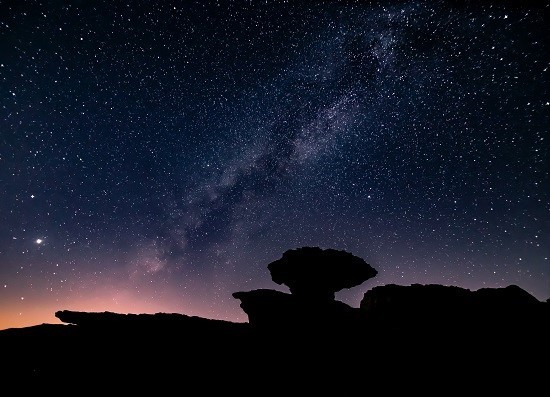My advice to people moving to any country is always the same: “Find the frisbee people.” That’s how I met Abdallah Ramadan, a
Jordan University (JU) physics student affectionately nicknamed “Nash” by his Dungeons & Dragons buddies in reference to John Nash, the acclaimed American mathematician and subject of the film
A Beautiful Mind. When I met Abdallah at his first frisbee practice in 2019, I didn’t know that he was much more interested in a different type of flying saucer, as he is the youngest sitting board member of the Jordanian Astronomical Society.
اضافة اعلان
This revelation came to me when he invited me, along with others from Amman’s regular Tuesday night ultimate frisbee pick up game, to participate in what might be Jordan’s best-kept tourism secret: a JD40 all-inclusive trip to Wadi Rum for a night of stargazing, hosted by the Jordanian Astronomical Society.
The trip included a laser pointer presentation, guided observations of Jupiter’s moons through the society’s Meade Cassegrain 10” telescope, and a two-hour lecture on the history of the universe and its celestial contents by some of Jordan’s most enthusiastic amateur astronomers.
 (Photo: Ibrahim Rantissi/Jordan News)
(Photo: Ibrahim Rantissi/Jordan News)
As nice as a JD229 stay in a luxury eco-bubble with an extra fee for a stargazing excursion sounds, I’ll take my Bedouin tent, a plate of mandi picked up in Maan on the way, and a passionate lecture by some of Jordan University’s best and brightest over the tour company “glamping” experience any day.
We were an eclectic group of travelers on the bus ride down to the desert, a diverse crew of foreign frisbee players, JU physics majors, retired professors, and some friends of Nash who had the good fortune of being coaxed into coming on the trip. At first, though, it was just Nash who greeted us at the society’s unassuming headquarters on a quiet street just up the hill from Amman’s bustling Gardens Street.
“I grew up in this place; I joined when I was nine years old,” he said, clearly feeling nostalgic as he showed us the us aging photos on the wall. “It started with 12 members, and now we have more than 5,000.”
He pointed out one photo next to the original charter document, a polaroid of the society’s original group of 12 founding members posing with American astronaut Neil Armstrong, and then needlessly apologized for the room’s vacant and disheveled appearance – all of the furniture was up against the walls because the day before our trip was the society’s first in-person lecture since the onset of
COVID-19. However, they faithfully continued to deliver their regular Thursday night lectures online throughout the pandemic.
I was moved as I reflected on how many people had probably passed through this unassuming building where every week for decades, professional and amateur Jordanian astronomers have gathered to share their passion for science and listen to lectures on quarks and quasars, exoplanets, the James Webb telescope launch and its implications for the future of human knowledge, and a hundred other things I’ve never heard of in neither English nor Arabic.
It was inspiring to go to
Wadi Rum for the first time with such a group of abstract-minded scientists and free thinkers. While Jordan’s most famous landscape is as spectacular as advertised, a surreal and martian landscape in its own right, for these astronomers, the vast expanse of red desert and monolithic geological structures is merely a gateway to galaxies beyond, a spectacular sitting room to bear witness to the stars, sparkling jewels dotting an incomprehensible infinity.
At one point in the lecture, somewhere between the myth of Orion the hunter and his nemesis Scorpio and an explanation of how to locate the north star using Cassiopeia, Nash talked about the NASA Kepler telescope, which was launched into an earth-trailing heliocentric orbit in 2009 to survey a small portion of the Milky Way in search of exoplanets — planets outside of our own solar system. He informed us that during its nine years of operation, the Kepler telescope had detected over 2,000 of such planets orbiting stars in galaxies we did not even know existed.
When he rhetorically asked us to imagine what we would find if we had the power to explore the entire sky, I had to chuckle to myself — I have friends and neighbors back home who have never even heard of Jordan. From the cultural standpoint of a guy from Rhode Island, Wadi Rum might as well be an exoplanet.
Nash concluded his lecture with a reference back to the previous day’s lecture at the society headquarters, reminding us all that
NASA would be launching the James Webb telescope on December 22 of 2021, sending the largest space telescope humans have ever built to orbit the sun at a fixed geo-solar point. I could hear the awe in his voice as he told us, “It will open our eyes to the vastness of the universe and the first moment after the Big Bang. It’s going to change our perspective of the universe; it’s going to be revolutionary.”
I think he’s right, and though it may seem that the night’s focus on the massive scale of the universe would lead to a reconsidering of the tiny piece of it which we humans inhabit as insignificant, it made me appreciate the majesty of a place like Wadi Rum all the more.
Space is cold, but I was feeling cozy and warm once we eschewed the distant sun for the closer focal point of a hot campfire, sipping tea boiled over the coals and feeling at home as we waited for daybreak to bathe the desert’s red sands in gleaming light.
Read more Where to Go



